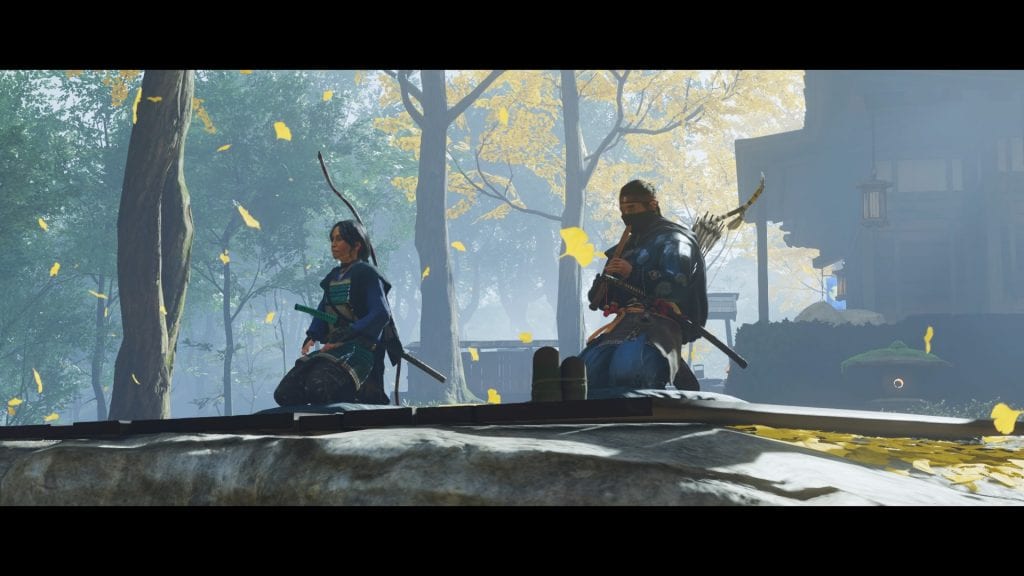*This piece contains gameplay and story spoilers for the first act of Ghost of Tsushima.*
It’s only fitting that the PlayStation 4’s last console exclusive is one of its most interesting. Offering fun combat and a beautiful open world, Sucker Punch Production’s Ghost of Tsushima (2020) is the much-needed breath of fresh air before the PlayStation 5’s release later this year.
When I saw the swan song of Sony’s current generation was a third-person open-world action-adventure game, I was disappointed. I saw little reason to buy it besides its impressive bouts of beauty. I expected to be let down by another game heavily inspired by Ubisoft’s Assassin’s Creed series – riddled with mechanics and systems that would be fun for an hour, but tiresome after three. A tried and true formula brings nothing new to the table, after all. This would have been even more disappointing coming off the heels of Naughty Dog’s summer blockbuster The Last of Us Part II.
It wasn’t until I completed the game’s introduction and started to explore the world that I realised I was wrong. Ghost of Tsushima is a lot deeper than it seems. Not only has Sucker Punch proved they can conceive one of the most impressive open worlds in gaming, they have excelled at marrying narrative and gameplay concepts seamlessly, resulting in an engrossing player experience.

Ghost of Tsushima succeeds where most games of the genre often misstep. A lot of games allow players to level up their character with experience points awarded by killing an arbitrary amount of enemies or by completing objectives. These points give characters new abilities that should make the player feel like they are getting stronger as they progress through a game’s story. However, this often creates a dissonance between the skill being unlocked and the context in which it was obtained. For example, the skill ‘Balanced Aim’ from Horizon Zero Dawn (2017) gives players the ability to aim while walking on tightropes. The game fails to make an effort to connect the ability to how it was earned. It also makes little sense that the player’s character, Aloy, couldn’t do this from the beginning of the game. Aloy, like many characters in the game, grew up in a world learning to climb and fend for herself.
It is by twisting these genre stereotypes that Ghost of Tsushima shines brightest. The game begins by introducing players to their playable character, Jin Sakai, who is left beaten and slightly broken after an unsuccessful attack on an invading Mongol army. After this beating, the player knows they must take Jin on his journey to grow stronger in order to reclaim his home from invaders. Ghost of Tsushima is laden with side-content that can be used as an upgrade in some way for Jin; ranging from finding hot springs that increase his health, to bamboo stands he can strike down in a mini-game that increases the amount of times he can heal, to observing and fighting Mongol camp leaders in order to learn more fighting techniques. In order to unlock most of these upgrades, these activities are required to be completed multiple times. This encourages players to go out of their way to explore the world and find them, so they can proceed without feeling underpowered or overwhelmed.
Alongside all of this, the player will craft armour and weapon upgrades with materials found on the island. As well as finding these upgrades during exploration, Jin’s legend grows as more of the island is liberated, awarding technique points to invest even more into his already growing skill tree.
By rooting these upgrades firmly within the game world, a natural power crawl has been created, making the player feel Jin get stronger on his journey to protect his home, instead of only seeing it. It is a rare thing to see narrative and gameplay tied together so tightly.
I spent almost every moment of Ghost of Tsushima’s first act searching for things I could use to upgrade Jin; following foxes and yellow birds for charm upgrades, taking down Mongol camps so I could become better at combat, even striking bamboo so I could survive longer.
If it were any other game, side-content like this would have bored me, as it often leads to nowhere and only exists for the sake of padding and inclusion. Such a game would push me to complete the main story and put it away for good, instead of rinsing it for all of its worth.
Words by Dan Davies
